LATEST NEWS


TARP – the infamous Troubled Assets Relief Program that bailed out Wall Street in 2008 – is over. The Treasury Department announced it will be completing the sale of the remaining shares it owns of the banks and of General Motors.
But in reality it’s not over. The biggest Wall Street banks are now far bigger than they were four years ago when they were considered too big to fail. The five largest have almost 44 percent of all US bank deposits.
That’s up from 37 percent in 2007, just before the crash. A decade ago they had just 28 percent.
The biggest banks keep getting bigger because they can borrow more cheaply than smaller banks. That’s because investors believe the government will bail them out if they get into trouble, rather than force them into a form of bankruptcy (as the new Dodd-Frank law makes possible).
» Read more about: It’s Time to Roll Up the Welcome TARP for Big Banks »


The following infographic first appeared with frugaldad.com‘s “College Isn’t Cheap” post and is republished with permission.


In 1996 I began working at the Parent Center of Wilmington Middle School. I quickly learned how students suffer from asthma, respiratory deficiencies, malnourishment, cancer and autism. Many of these poor health conditions are linked to the pollution and poverty of the area.
I decided to join the Coalition for Clean & Safe Ports, hoping to help clean our air and reduce disease in my community. Over the past several years we have made huge progress. I believe these accomplishments were possible because so many of us came together, from residents and community-based organizations to port truck drivers, lawmakers and unions. Although it is a cliché to say there is strength in unity, in this case it was true.
Today we are fighting to change the conditions of port truck drivers – and we are still unified.
We believe that everyone who works should be valued by their employer.


2013 is making it difficult to avoid one of America’s greatest sins—slavery. We’ve just marked the 150th anniversary of the Emancipation Proclamation, and a plethora of films, documentaries and TV specials are scheduled to address slavery.
One blockbuster hit that’s playing in cinemas now, and is likely to walk away with several Golden Globes and Oscars, is Quentin Tarantino’s Django Unchained.
Django Unchained depicts a slave-turned-bounty hunter (Jamie Foxx) who fearlessly treks across the U.S. to find his wife (Kerry Washington) in order to rescue her from a brutal Mississippi plantation owner (Leonardo DiCaprio).
The film is classic Tarantino; this time a homage to the spaghetti western with romance and revenge narrative. Tarantino set the story in the most unlikely of places— America’s Deep South before the Civil War in 1858.
Tarantino is known as the “King of Carnage,” and his films’ aestheticized depictions of violence (which he calls “movie violence”) is both cruelly disturbing yet undeniably entertaining.
» Read more about: The Peculiar Controversy: Quentin Tarantino’s “Django” »
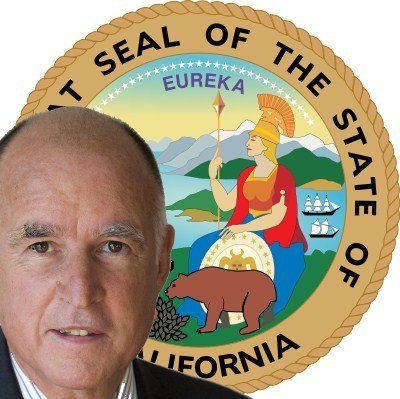
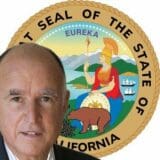
Expect scuffles between Jerry Brown and legislative Democrats over the governor’s budget blueprint.
California’s social services have certainly been cut to the bone during the recession. But Brown’s proposal for a balanced budget is a remarkable and critically important achievement which sends a message to the rest of the country:
That the bluest of all the big states can get its fiscal house in order. This was enabled, of course, by the modest tax increases in Prop. 30, passed by voters in November. Watch here as a buoyant and frisky Jerry Brown explains – in his own inimitable way – what this means.
California’s balanced budget is a repudiation of claims by conservatives that only Republican-led states can manage their books and grow their economies. Thirty states have Republican governors and all but six of them have legislative majorities, making possible all sorts of right-wing mayhem on worker,


The New York Times and other sources report today that Aaron Swartz, a co-founder of the social news site Reddit, was found hanged in his Brooklyn apartment. “At 14,” the Times noted, “Mr. Swartz helped create RSS, the nearly ubiquitous tool that allows users to subscribe to online information.”
The 26-year-old computer prodigy was under federal indictment for hacking into JSTOR, an online academic resource whose materials are available on a subscription-only basis, and making nearly its entire library of literary and scientific articles available to the public.
At the time of his death Swartz was awaiting trial and faced up to 35 years in prison. (In 2009, Swartz hacked into the U.S. government’s PACER system, which tracks federal court cases, and made available online millions of its documents. He was not charged in that incident.)
In a September 15, 2011 Frying Pan News post,
» Read more about: Internet Activist Aaron Swartz, 26, Apparent Suicide »
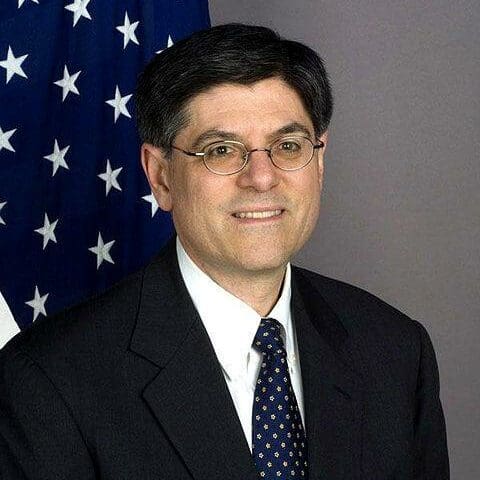

As President Obama prepares to nominate his current Chief of Staff, Jack Lew, to the Treasury Secretary position, attention to Lew’s record and loopy signature is at an all-time high. Now, vigilant labor journalist Josh Eidelson has unearthed information on Lew’s pivotal role in busting the NYU grad student union.
The NYU graduate student union, which enjoyed official status from 2000 to 2005, was the only graduate student union to ever exist as a private university. Functioning as a case study for the political swings of the NLRB as well as a number of graduate student and adjunct professor organizing drives, the NYU Graduate Student Union (GSOC) has persevered as an informal organizing group regardless of official recognition.
The GSOC enjoyed support from within NYU and outside of it, and they didn’t lose their official bargaining status without a fight. Eidelson reports for Salon:
While graduate student teachers and researchers are unionized at many public universities,


Every year millions of Americans are victims of what some call wage theft — a practice in which a company fails to compensate workers for their time, short-changes them on their benefits or intentionally misclassifies employees in order to save money. And even though all that is illegal, Kim Bobo, executive director of Interfaith Worker Justice and author of Wage Theft in America, says it’s surprisingly common in the U.S.
“Minimum wage and overtime violations are two of the most common ways that wage theft occurs. Another way is payroll fraud, when employers intentionally call people independent contractors when they are really employees. Now if your boss — not you — declares you an independent contractor, you probably aren’t one. Then there is also tip stealing. About 10 percent of tipped workers actually don’t get their tips; their employers just don’t give it to them,” says Bobo.


A federal judge Thursday ordered Walmart to be included in a lawsuit filed by warehouse workers embroiled in a labor dispute with employers contracted by the retail giant. In downtown Los Angeles, United States District Court Judge Christina A. Snyder denied Walmart’s request to be excluded from the case (Carrillo v. Schneider Logistics, Inc.), which began litigation in October, 2011. At that time, several warehouse employees in Mira Loma filed suit against Schneider Logistics, Inc., Premier Warehousing Ventures, Rogers-Premier Unloading Services and Impact Logistics, Inc. for alleged violations of federal and state labor laws.
Walmart had argued that the plaintiffs had waited too long before seeking to include Walmart as a defendant. This delay, Walmart claimed, placed the company in the unfair position of having little time to catch up with discovery evidence and to prepare for an anticipated plaintiff class-action motion later this month. The Bentonville, Arkansas corporation also argued against inclusion in the suit because Walmart is not the warehouse workers’ employer.
» Read more about: Warehouse Workers Win New Round in Walmart Case »

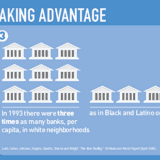
Infographic Source: ACLU and aclu.org’s “Big Profits, Broken Dreams”
» Read more about: How Banks Subprimed Black and Latino Morgtages »
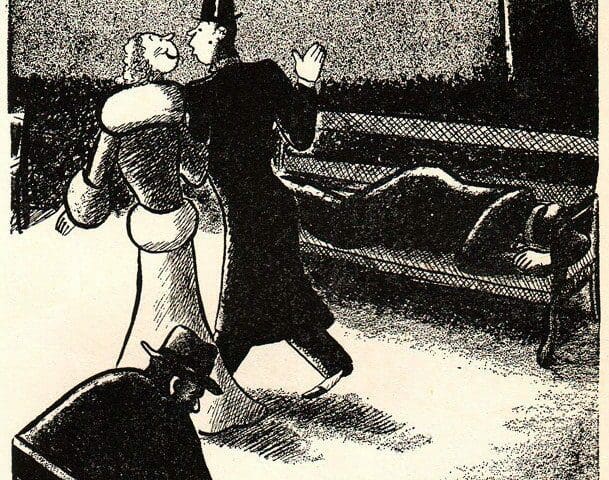

How much do the newly enacted tax hikes on the wealthiest Americans actually affect them? Hardly at all.
Almost all of the debate that convulsed Capitol Hill in December concerned the reinstatement of the highest marginal tax rate on earned income — that is, on wages and salaries. But as Fitzgerald said, the rich are different from you and me, and one of the primary ways they’re different is that they don’t get their income from wages and salaries.
In 2006, the bottom four-fifths of U.S. tax filers got 82 percent of their income from wages and salaries, a Congressional Research Office study found. The richest 1 percent, however, got just 26 percent of their income that way; for the richest one-tenth of 1 percent, the figure is just 18.6 percent.
The study also looked at dividends and capital gains. The bottom four-fifths got just 0.7 percent of their income from those sources.
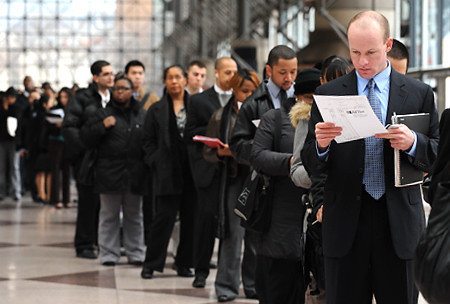

The news today [January 4] from the Bureau of Labor Statistics is that the U.S. job market is treading water.
The number of new jobs created in December (155,000), and percent unemployment (7.8), were the same as the revised numbers for November.
Also, about the same number of people are looking for work (12.2 million), with additional millions too discouraged even to look.
Put simply, we’re a very long way from the job growth we need to get out of the gravitational pull of the Great Recession. That would be at least 300,000 new jobs per month.
All of which means job growth and wage growth should be the central focus of economic policy, not deficit reduction.
Yet all we’re hearing from Washington — and all we’re likely to hear as Republicans and Democrats negotiate over raising the debt ceiling — is how to cut the deficit.
» Read more about: Jobs Must Be Our Goal, Not Deficit Reduction »


According to the New York Times’ DealBook page, insurance giant American International Group announced today it will not join a shareholder lawsuit against the same federal government that had rescued it from extinction during the 2008 financial meltdown.
The suit, led by former AIG CEO Maurice R. Greenberg, is seeking $25 billion, alleging that the government’s “onerous” bailout terms prevented shareholders from making billions of dollars as the company emerged from its financial coma.
The Times noted that “A.I.G. directors faced a difficult choice.” That’s putting it mildly, as AIG found itself confronted by a PR firestorm in the days leading up to its decision, when both public and congressional outrage mounted over the company’s possible involvement in the suit. If the company joined the suit, it would have looked like the man who sues the fire department that saved him from a burning home but didn’t return to fetch his stamp collection.
» Read more about: AIG on Suing U.S. Government: “Never Mind” »
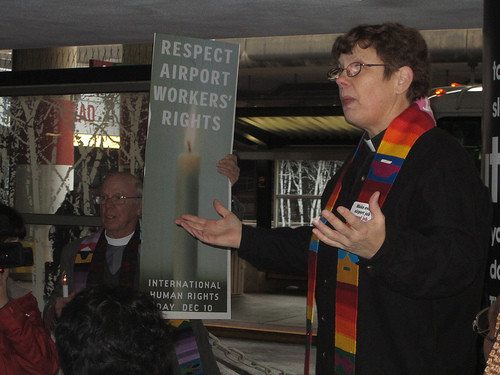
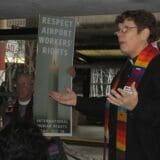
December 12 marked the 65th anniversary of the United Nations’ Universal Declaration of Human Rights. Probably most of us think first of human rights on the political level: the rights of people, especially of political prisoners across the world, to speak, assemble and write, free of government constraint.
In Seattle a group of about 100 workers, community, labor and faith leaders celebrated Human Rights Day at Seattle International Airport (SEATAC) in a different context. We were there in support of airport workers subcontracted by Alaska Airlines, which is based here: baggage handlers, wheelchair operators, cabin cleaners and aircraft fuelers. As we paraded by the Alaska ticket counters we adapted and chanted phrases of the U.N. Declaration: “…May everyone have the right to just wages…May everyone have the right to human dignity.
Socrates, a baggage ramp employee who works for Menzies Aviation, the subcontractor (and a multinational company that contracts with airlines in 29 countries),
» Read more about: Restless in Seattle: Airport Workers Seek Dignity »


Progressives are rarely satisfied. It is part of our political DNA. There’s so much injustice in the world, it’s sometimes hard to feel that we’re making progress. But as Chinese philosopher Laozi reminded us, a journey of a thousand miles begins with a single step.
As I document in my book, The 100 Greatest Americans of the 20th Century: A Social Justice Hall of Fame, the radical ideas of one generation are often the common sense of the next generation. One hundred years ago, ideas like Social Security, the minimum wage and women’s suffrage were considered radical. Fifty years ago, most African-Americans in the South couldn’t vote, few women were welcome in politics and many professions, and all but a handful of gays and lesbians were locked in the closet. In other words, if we take a long view, we can see that things do often change for the better,
» Read more about: Peter Dreier’s Top 25 Progressive Victories of 2012 »


Using data from the American Consumer Satisfaction Index, Business Insider writer Max Nisen has compiled a list of companies with the worst customer service ratings. (This came to us via LA Observed.) Read and weep! It’s not as though many people can easily avoid these outfits – they tend to be regional monopolies or dominant companies in their fields.
In order of unhelpfulness, they are:
1. Long Island Power Authority (color them Sandy)
2. Northeast Utilities (New England)
3. Charter Communications Television Service
4. Comcast Television Service
5. Facebook
6. United Airlines
7. Time Warner Cable
8. LinkedIn
9. Cox Communications Television Service
10. American Airlines
11. Twitter
12. US Airways
13. Delta Airlines
14.
» Read more about: Customer Service: The 15 Worst Companies »


There’s a moment in Mordecai Richler’s novel, The Apprenticeship of Duddy Kravitz, in which a Montreal old-timer rapturously recalls the early rise of a shady neighborhood businessman:
“All that time he’s collecting streetcar transfers off the street and selling them, see. Nerve? Nerve.”
Yesterday Americans began reading about a different kind of business nerve. According to the New York Times and other sources, American International Group, the insurance titan and poster child for government bailouts of the financial sector, is considering suing the very government that loaned it $182 billion. AIG’s legal thinking is that, while it was all very good of the Treasury Department and Federal Reserve Bank of New York to come to its rescue, the terms of that rescue inflicted unfairly high losses on the company’s shareholders.
All this comes during a publicity campaign in which AIG has been thanking Americans for saving its skin during the 2008 economic meltdown that led to a long recession.
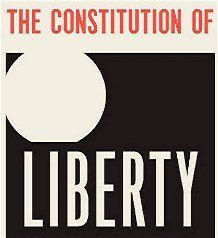
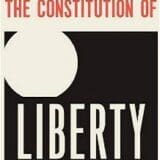
Progressive commenters reeling from the “right to work” defeat in Michigan have in turns unmasked and (grudgingly) admired proponents of the new law. The unmasking is fairly easy. Michigan governor Rick Snyder actually unmasked himself. After claiming that he was a moderate who would avoid polarizing fights, he pounced on the opportunity to jam “right to work” through a lame duck legislative session. And the policy itself is not hard to expose. “Right to work” is portrayed by proponents as freeing unwilling workers from paying union dues. But as many critics have pointed out, its wealthy proponents’ main purpose is to hobble labor by allowing some workers not to pay for the representation and protection unions are legally obligated to provide them.
As for the admiration, well, there is much to be learned from the planning and persistence of the rich donors and think tanks for whom spreading “right to work” laws beyond the former Confederacy has long been an aspiration.
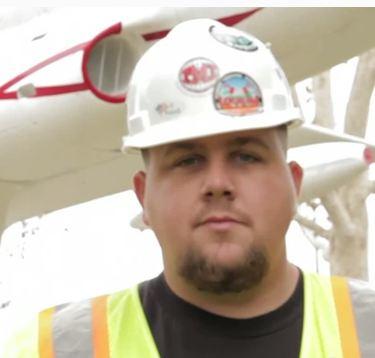

“From the Ground Up” (or FTGU) is a new monthly video collaboration between LAANE’s Construction Careers Project and the UCLA Labor Center’s California Construction Academy (CCA). This series will show the fascinating, real-life stories related to construction, one of the best paths to middle-class opportunities for low-income communities in an era of globalization and education budget cuts.
FTGU will be profiling unique, diverse individuals within the construction trades, ranging from veterans to women to former convicts to youth of different incomes and ethnicities. We will also bring together experts on the construction industry, urban planners, economic theorists and others to look at the bigger picture of how construction jobs that build tomorrow’s public infrastructure can impact residents’ lives and, ultimately, our economy.
In this first video we interview Philip and Rich, two former veterans-turned-construction workers in Inglewood and Lakewood. Philip’s military experience and kids led him to sheet metal work, which has helped him find a greater sense of inner peace.
» Read more about: Vets: Be All You Can Be With Construction Jobs »


Many younger Americans probably know very little about Eleanor Roosevelt, and if their first encounter with her is the new film Hyde Park on Hudson, what they’ll learn is incredibly misleading and inaccurate. Other films – including Sunrise At Campobello (1960), the two-part Eleanor & Franklin HBO mini-series (1976), Eleanor, First Lady of the World (1982) and Warm Springs (2005) – have depicted different aspects of her life. But Hollywood can’t seem to make a film that accurately portrays the depth and influence of Eleanor’s radicalism.
Hyde Park on Hudson focuses on the relationship between her husband, President Franklin Roosevelt (played by Bill Murray) and his distant cousin Margaret “Daisy” Stuckley (Laura Linney) during a weekend in 1939 when the King and Queen of England are visiting the Roosevelts at their second home in upstate New York. The film shows FDR and Stuckley having a sexual love affair,
» Read more about: Eleanor Roosevelt: Still Waiting for Her Closeup »